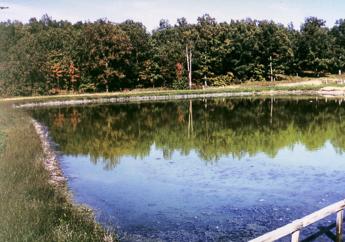Missouri Engineering Corp., a contractor for the city of Camdenton, originally coordinated the sludge removal from the lagoon during closure activities in July 1989. Although the closure was approved by the department’s Water Pollution Control Program, there was no knowledge of contamination at the lagoon at that time and the closure was not designed to meet the requirements of the Missouri Hazardous Waste Management Law and regulations regarding cleanup.
In November 1996, Dames & Moore performed a soil investigation at the former City Lagoon #3, as part of the site investigation occurring at the 221 Sunset Drive manufacturing facility. The investigation was performed to determine whether volatile organic compounds, particularly TCE, were present and whether the lagoon was the source of the TCE contamination in the groundwater. Sampling results from the investigation confirmed TCE was present in the soil near the former lagoon outfall and near the center of the former lagoon. Because of the legal limitations imposed on the department’s ability to use RCRA authority to investigate the groundwater contamination, the site was referred to the department's Superfund Section, to be regulated under CERCLA authority.
Preliminary Assessment/ Site Inspection
Following the Superfund site investigation process, the department began a Superfund investigation at the lagoon in 1998. The department conducted a combined preliminary assessment/site inspection at the site in 1999. Groundwater sampling results documented a release of TCE to the Ozark Aquifer, in the area of the City Lagoon #3 site.
Remedial Investigation/ Feasibility Study
In 2000, Hamilton-Sundstrand Corp., parent company of former Sundstrand Tubular Products and a subsidiary of United Technologies Corp. (UTC), entered into a voluntary letter of agreement with the department, in order to enter Superfund's Cooperative Program to clean up the site. In 2003, Hamilton-Sundstrand performed a remedial investigation/ feasibility study to investigate groundwater contamination caused by historic releases of TCE and other VOCs at the former City Lagoon #3 site and to evaluate possible cleanup alternatives. The Remedial Investigation Report was submitted to the department in 2003, and Feasibility Study in October 2004. The Feasibility Study listed the cleanup alternatives that were possible for the Mulberry Well. During the negotiations for the cleanup action it was determined additional investigation work was necessary to properly assess the cleanup alternatives. Due to data gaps, the department requested a supplemental remedial investigation/ feasibility study.
Supplemental Remedial Investigation
In 2006, the department's Superfund Section conducted an investigation along the city sewer line, between the 221 Sunset Drive manufacturing facility and the former City Lagoon #3 site. Soil sample results confirmed TCE was present in the soil along the sewer line and may be a potential source of TCE in the Mulberry Well. Superfund conducted additional investigation of the groundwater contamination related to this part of the sewer line. For the most part, the remedial investigation was complete in 2010. Both the 221 Sunset Drive manufacturing facility and the City Lagoon #3 appear to be contributors to the TCE groundwater contamination in the area.
In March 2016, the department, Hamilton-Sundstrand, Modine Manufacturing Co. (then owner of the 221 Sunset Drive manufacturing facility) and the city of Camdenton entered into an Abatement Order on Consent. The city is a responsible party since they owned and operated the lagoon. (The AOC has an incorrect date; however, due to it being a legal document, no correction can be made. The dates listed on this webpage are correct.)
The Supplemental Remedial Investigation Report Addendum describes the Mulberry Well site characterization activities. The characterization determined areas within the well borehole that contribute to the water production to the well. The volume of water produced within each area was determined to calculate the optimum pumping rate to maintain hydrologic control of the TCE contaminant plume. For more details about how the contamination is being controlled, visit Mulberry Well.
Soil Gas Investigation
In 2015, vapor intrusion investigations began with regards to the 221 Sunset Drive manufacturing facility. In October 2017, on behalf of Hamilton-Sundstrand, Geosyntec Consultants Inc., submitted a soil gas investigation work plan for the City Lagoon #3 site. The investigation was designed to determine whether the remaining contamination in the soil at former City Lagoon #3 is a source for TCE vapors that could present a risk to nearby structures.
Soil gas probes were installed and sampled in February and May 2018. Three additional rounds of soil gas sampling were conducted in August and November 2018, and July 2019. TCE was the only volatile organic compound detected above vapor intrusion screening levels, indicating sampling further from the lagoon was necessary. TCE concentrations in vapor decreased, the further away the samples were from the former lagoon. One building was within 100 feet of a probe where TCE was detected above the vapor intrusion screening levels. However, four rounds of indoor air testing had been conducted at the building as part of the vapor intrusion investigations relating to the 221 Sunset Drive manufacturing facility. No volatile organic compounds were detected above health based action levels.
The City Lagoon #3 soil gas investigation concluded that, while there are volatile organic compounds present in soil gas near the former lagoon, TCE concentrations decreased as it diffused beyond the edges of the lagoon. The vapor intrusion pathway between the former lagoon and surrounding buildings is not complete. No further vapor intrusion investigation at the lagoon is necessary.
In September 2020, the responsible parties submitted to the department a report containing feasibility study addendum activities, including a conceptual site model verification. The goal of the additional investigation activities detailed in the report was to determine a final remedy for groundwater contamination, which includes optimizing groundwater extraction to control the movement of TCE. The department reviewed the report and identified additional work needed to fill data gaps. The department is working with the responsible parties to complete the work necessary to close the data gaps. After necessary work is completed, the responsible parties will prepare a revised feasibility study addendum, including a revised conceptual site model verification.

